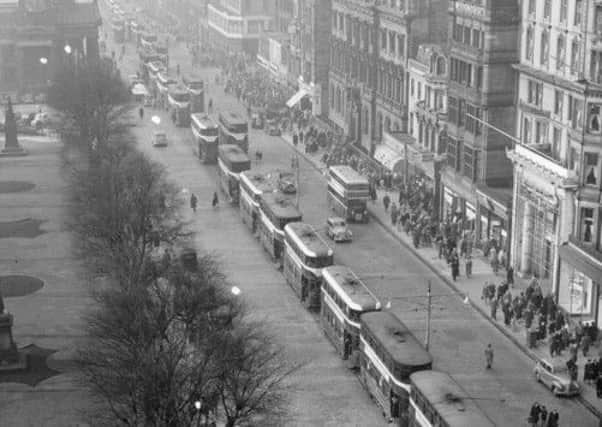Lost Edinburgh: Edinburgh Trams 1871-1956
This article contains affiliate links. We may earn a small commission on items purchased through this article, but that does not affect our editorial judgement.


Edinburgh’s 142 year affiliation with trams began on November 6th 1871 when the Edinburgh Street Tramways Company introduced a three-and-a-half mile horse-drawn line from Haymarket, via Princes Street and Leith Walk, to Bernard Street, Leith. This replaced an earlier coach service that had run along the same route – the only difference being the presence of guide rails that provided passengers with a noticeably smoother journey. Over the next decade the popular tram network began to sprout into new districts such as Newington and Portobello with further expansion significantly hindered by the notorious rough terrain in certain areas of the city. It is said that as many as five horses were required to tackle the formidable slopes of the New Town. In January 1888 this problem was cracked with the advent of the cable hauled system, a method that was already in use in San Francisco – a city renowned for its steep elevations much like Edinburgh. The cables ran in a channel in the middle of the track and were steam-driven from four power stations. The tramcar employed a gripping mechanism which dropped into the channel and connected the vehicle to the running cable, hauling it along at a leisurely 12mph. The new technology enabled the tramcar to appear in areas of the city that had hitherto proved too difficult for horses to negotiate. It was also around this time that the Shrubhill Works in Leith began to produce its own unique models of tramcar.
Switch to electric
In 1905 when the newly created Leith Corporation Tramways pioneered the use of electric traction, an anomaly appeared that would take nearly twenty years and the unification of two separate autonomous burghs to sort out. Since Edinburgh’s system was predominantly cable-run and Leith’s electrified, passengers travelling either way along Leith Walk were forced to change vehicles at the Pilrig city boundary. The hugely unpopular merger between the two burghs in 1920 (the result of a referendum in which Leith residents voted five to one in opposition) formed the catalyst for the upgrade of the Edinburgh network to an electric system. Electric trams finally crossed the frontier on June 20th 1922 and the chaotic interchange known as “the Pilrig muddle” was eradicated. Edinburgh’s last cable tram operated a year later on the Portobello line. Today a short section of original tram rail and cable track remains in situ at Waterloo Place, the sole surviving relic of the old system in central Edinburgh.
Advertisement
Hide AdAdvertisement
Hide AdTrams in Edinburgh, Leith and the surrounding area were now controlled by the Edinburgh Corporation, a forerunner of today’s City of Edinburgh Council. The Edinburgh Corporation adopted the distinctive dark red madder and white livery on its tramcars that is still in use today on many of the city’s buses.
Move to buses
In the years following the end of World War II, trams began to fall out of favour across the United Kingdom. Post-war urban expansion and the creation of new towns required a cost-effective transport solution. This arrived in the shape of the motor bus which could offer limitless flexibility compared with the restricted rail-bound trams. The gradual closure of tramways across the country over the next decade signalled a shift in preference for British civic transportation. Despite the Edinburgh Corporation initially taking advantage of the situation by adding eleven former Manchester cars to the fleet between 1947 and 1949, the end was nigh for the trams. The decision to cease operation of the city’s 47 route-miles of tram network arose in 1952, taking just 4 years to dismantle.
The final day of the trams fell on the 16th of November 1956. That evening, a procession of tramcars made its way from the Braids terminus to Shrubhill depot in Leith, taking in much of the original 1871 route. Ten trams were laid on due to the demand for tickets - one car containing the very city councillors who had consigned the trams to the history books in the first place. At the Mound an enormous crowd gathered to bid an emotional farewell to a much cherished thread of the city’s colourful fabric. From the hundreds of cars that graced the city over the years, only tramcar No.35, built at Shrubhill in 1948, has survived. It is located at Crich Tramway Museum in Derbyshire.
After a gap of 58 years, a new Edinburgh tram network is due to open in summer 2014.
• More intriguing insights into Edinburgh’s past can be found on the Lost Edinburgh Facebook page